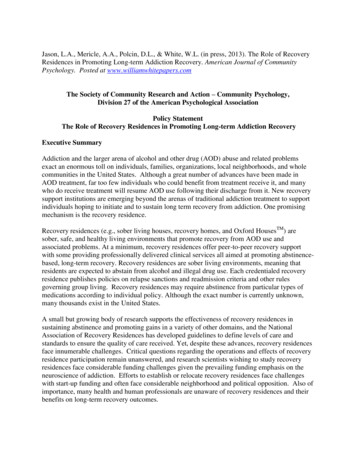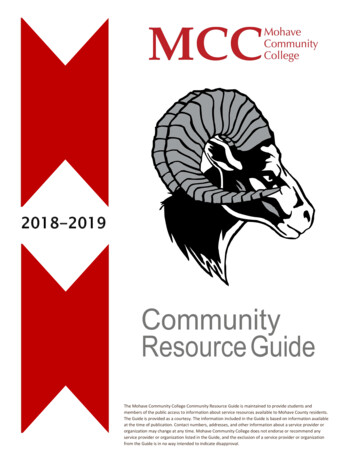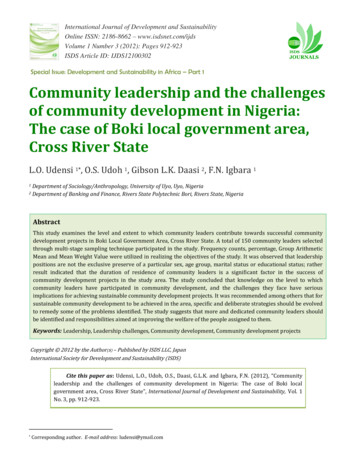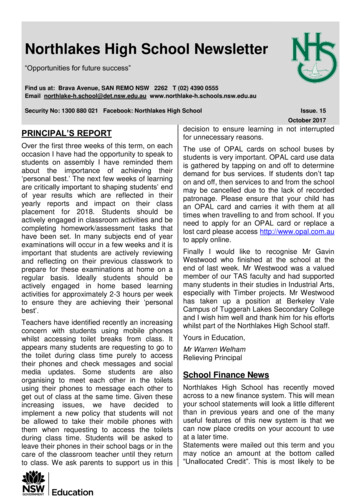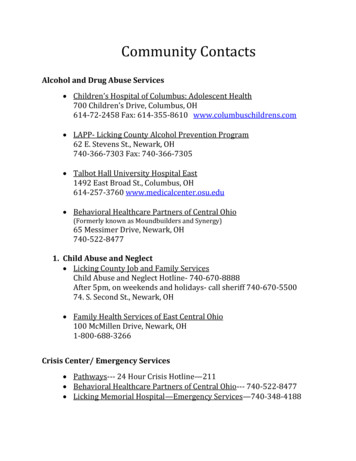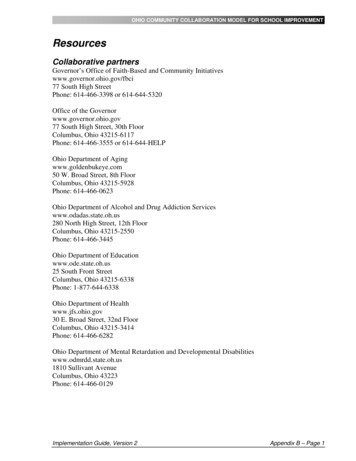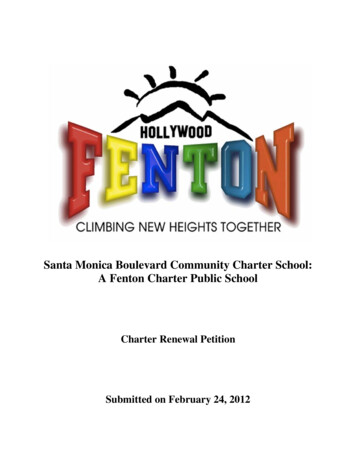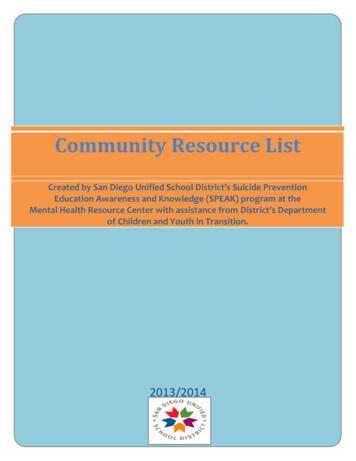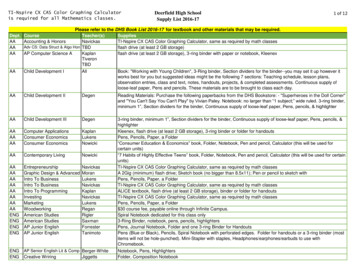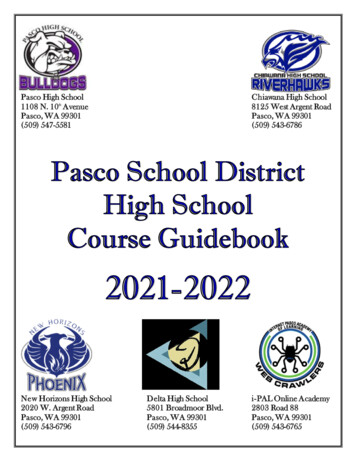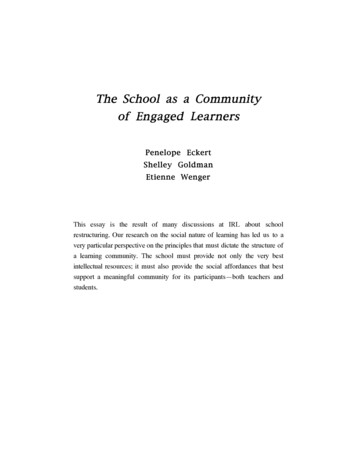
Transcription
The School as a Communityof Engaged LearnersPenelope EckertShelley GoldmanEtienne WengerThis essay is the result of many discussions at IRL about schoolrestructuring. Our research on the social nature of learning has led us to avery particular perspective on the principles that must dictate the structure ofa learning community. The school must provide not only the very bestintellectual resources; it must also provide the social affordances that bestsupport a meaningful community for its participants—both teachers andstudents.
Learning in SchoolLearning is a basic and ubiquitous human activity. Society is based on learning,communities are held together by learning, and people construct identities through learning.Yet learning becomes problematic in school, where it is assumed that some people will learnand others will not, and where it is assumed that learning is something that kids will only dounder coercion. Kids’ engagement in non-school activities is viewed as a distraction fromlearning, but the depth of learning that takes place among kids involved in age-specificsocial activities is unequalled in the classroom. Unlike much of what is taught in school, theknowledge gained in collecting and trading baseball cards, stamps, or records, becoming a“Deadhead;” playing double dutch, Dungeons and Dragons, video games, highperformance Monopoly; playing in a garage band, or working on cars, tends to stay withpeople for the rest of their lives. Adults tend to view friendships, games, romance,collections, popular music, as attractive nuisances that prevent learning. But if the learningenergy that goes into these activities went into math or social studies, we would have anation of academic geniuses. In fact, learning becomes problematic in school to the extentthat the school focuses on learning as an endeavor in itself, rather than as a means tobuilding social relations and engaging in meaningful activity. No amount of change inschools will produce significant results unless the nature of school as a social entity is takenseriously. No amount of clever delivery of subject matter will capture the imaginations andenergies of students who feel that their opportunities for social development lie elsewhere.While many teachers know better, the organization of our schools currently embodies thebelief that kids’ social ties and activities are incompatible with learning. But individualslearn in the interests of participation in communities that matter to them. They learn in orderto know how to be productive in the community, and to gain access to valued forms ofcommunity participation. Their reward is in seeing their contribution, knowing that othersrecognize their contribution, and forging an ever changing sense of themselves. We take thisas given among adults, whose work is commonly integrated with their social lives. Scientistsmix social and scientific interaction, and forge their identities and connections around theirwork, their knowledge and their contributions to the scientific community. Yet kids inschool are currently expected to function differently—to learn in isolation from the socialThe School as a Community of Engaged Learners2
ties that bind them. In adult scientific communities, as in kids’ jump rope groups and garagebands, activity and social relations are closely intertwined. It is in this sense that we speak ofcommunities of practice. United by a common enterprise, people come to develop and shareways of doing things, ways of talking, beliefs, values - in short, practices - as a function oftheir joint involvement in mutual activity. Social relations form around the activities, theactivities form around relationships, and particular kinds of knowledge and expertisebecome part of individuals’ identities and places in the community. Most important,learning becomes the means by which people gain membership, and participate in, thesecommunities.To benefit from the tremendous learning energy that comes with social membership,schools need to provide the opportunity for students to form communities of practicearound subject matter. This does not mean that schools should build their curriculumaround rock ‘n roll or video games. It most decidedly does not mean that students need tobe cajolled or entertained into learning. These activities come into conflict with schoolprecisely because for many students, school offers no alternative—no opportunity to buildmeaningful lives around school work—no opportunity to express themselves throughparticipation in school learning.If kids are to have opportunities for full participation in school, the school must offercommunities of practice with the same drawing power as the students’ othercommunities—the same potential for participation that is offered in families, neighborhoods,communities, workplaces, clubs and so on. This drawing power depends, among otherthings, on possibilities for meaningful participation, and on compatibility with participationin communities of practice outside of school. If students are to take what they learn inschool into the rest of their lives, they must be able to bring what they learn elsewhere intoschool. Thus the communities that students form in school cannot be isolated from themany other communities in which they participate; the school is a viable community forstudents only to the extent that it supports their participation in other communities as well.A school must offer learning as a key to the world—as a key to an infinite number of waysof being and participating in the world. It must build on diversity, and create diversity. Wedo not want our students to come out of school with uniform knowledge; we want studentsleaving school to be not only knowledgeable, but self-directed, creative, and adaptable. Nordo students come into school with uniform knowledge; they come to school with differentThe School as a Community of Engaged Learners3
experience, different knowledge, different tastes, different ways of speaking, doing, andthinking. And they seek, in school and out, the means to expand, explore and express whothey are and how they fit into the world. For each student, the process must be different, andthat difference will be part of who the student is and part of the student's uniquecontribution to his or her various communities.Currently, the only legitimate opportunity for developing identities around learning in theclassroom is along a linear scale of "better" or "worse" student, based on the standardizedperformance of standardized tasks. This guarantees that the major social dynamicsmotivating learning will be competition among peers and the eagerness to please one'selders. Kids, like their elders, seek participation in communities that afford complex formsof membership and creative identities. In our traditional schools, the greatest opportunityfor creative social activity is in resistence or "subversive" behavior: disruption, cheating,tardiness, apathy, violence, drugs, self-destruction.IRL’s principles for school design are based on a vision of a school that providesopportunities for multiple forms of participation—that nurtures communities of practice inwhich students jointly develop their learning potential to its fullest. The vision is of a schoolin which learning is fostered as shared enterprise, participation, engagement, contribution,connection, experimentation, inquiry, reflection, identity. We list below some basic qualitiesthat such a school must have: Shared vision. Individual responsibility is the sense of connectedness that growsout of membership and participation in a community. In our learning community, allmembers—administrators, teachers, aides and students alike—are mutually engagedin reflection about their shared mission. All participants, not just a privileged few,have time for reflection. Vision can thus be a practice—an ongoing debate, ratherthan something handed down. And leadership can be something that is shared andthat spreads through learning. Supporting Common Purposes. Rewards within any community are an inherentpart of, and reflection of, community practice. A community that rewards solobravado will be a community in which personal success is sought at the expense of,and in competition with, others. The reward systems of our learning community willThe School as a Community of Engaged Learners4
support individual achievement, but within the context of community andcommunity-oriented efforts. Fostering diversity. A school that emphasizes standardized learning and activityprevents its students from creating meaningful roles and identities throughparticipation in school. In our ideal learning community, students are valued for theirdiverse backgrounds, experience, abilities, concerns, knowledge, interests andaccomplishments. And activities are conceived in such a way as to encouragediversity in forms of participation, contribution, and knowledge. Internal Openness. A learning community invites participation by striving tomake itself transparent to its members. Members find easy access to the resourcesthey need in order to be full participants: information, connections, opportunities.And with direct access to people, places, and activities, members’ participationbrings a sense of what the community is about, what possibilities it holds, what theirown futures can be. Openness to the world. It is part of the school’s purpose to help students forgeconnections between school, their home communities, and the globalcommunity—and to develop strong identities as members of all of thesecommunities. To do this, the school must be open to the world at large, enablingconnections between participation in school and participation in surroundingcommunities. Freedom to experiment. Active and engaged learning involves the risk of error.Schools must encourage students to take risks, and provide support for interpretingand building on error. It is the quality of the risk taken—the potential that the riskoffers for learning—that should be rewarded, rather than the glossiness or ease ofthe success.The School as a Community of Engaged Learners5
Principles of School DesignIf we are to be a nation of lifelong learners, school has to become a place where studentstake charge of their learning for life—where they become eager constructors of knowledge,and view the entire world around them as a rich and welcome resource. For this to happen,schools must undergo a transformation at the most fundamental level, based on a completelydifferent understanding of learning and of the nature of schools as social entities.The principles of school design that we discuss here are based on a fundamentally differentview of how people learn than is currently embodied in general school practice. There aremany teachers, schools, districts and communities that embrace many or all of theseprinciples: there are exciting model schools, model programs, and grass roots innovations inall aspects of practice. But the view of learning and schooling as an enterprise in“knowledge delivery” continues to dominate our society, and straightjackets manyvisionary practitioners. The educational system is commonly treated as a neutral repositoryinto which new methods can be unproblematically deposited; or as a tired system justwaiting for the right injection of innovative pedagogy or technology. In this shortdocument, we will not discuss pedagogy, facilities, materials or technology. Innovation ineach of these, in its time, has been considered a panacea for the problems of education. Butwhile each is important, none of them will bring about significant change alone, and theirvalue will depend on the extent to which they are developed in the service of the needs of alearning community. It is for this reason that we set out below some principles of schooldesign that are essential for the construction of such communities.1. Students Are Engaged LearnersEngaged learning occurs when people appropriate the learning process in the service of theirgoals as individuals and as members of society. Engagement is not just the involvement ofthe sole individual in learning; rather, learning is the vehicle for the individual’s engagementwith a community and with society at large. Schools must provide students with the meansto engage in learning for the sake of their membership in a variety of communities. In orderThe School as a Community of Engaged Learners6
for people to be engaged learners, they must see the value of learning, they must see theirown potential as learners, and they must have access to resources for learning.The school recognizes the learner in every student.The purpose of schooling is not to sort students according to their apparent ability orinability to learn, but to bring out and enhance their ability. All young people seek asuccessful and rewarding life, and it is the school’s responsibility to guide themsuccessfully in that search. Kids’ belief in themselves begins with others’ belief in them,and others’ commitment to them. Above all, then, the school must be a place where eachstudent is important, where each student succeeds, and where all activities are geared aboveall to the benefit of students.Students take charge of their learning.Engaged learners plan, implement, and assess their learning in relation to goals that havemeaning for them as well as for the community and the wider society. This has implicationsfor changes in all aspects of schooling, and can only come about through radical change.Isolated reforms such as portfolio assessment have been introduced in order to encouragestudents to take responsibility for their own progress. However, inserted into a system inwhich the opportunity for such responsibility is otherwise severely limited, innovations thatmight otherwise foster engagement can ultimately add to the weight of a system that fosterspassivity.School articulates with the student’s other communities, rather than settingup conflicts of identity.Students come into school with knowledge and experience that is grounded in othercommunities. The role of school is to help students expand that knowledge andexperience—to support this participation in multiple communities. A school that is open tothe world is first of all open to the local community—it goes out to students’ families andneighborhoods, and it invites them in. It supports students’ connections with problems,issues and knowledge of communities beyond their own, forging connections between theirown experience, that of others in their communities, and that of the communities that makeup their growing world.The School as a Community of Engaged Learners7
The curriculum has to be clearly of use to students’ broader endeavors in their communities,and in the wider society, rather than simply within a closed system of schooling. Thepurpose of school should be to grasp students' natural eagerness to learn and show themhow to use that eagerness to build a productive and rewarding lifetime in their communitiesand in the world community. School learning, then, should not conflict with or be keptseparate from informal and everyday learning; rather, it should be integrated into the lives ofthe communities that the institution serves, rather than isolating students from theircommunities. This does not mean that curriculum must all grow out of community interests,but it does mean that it must be integrated into those interests. Students have to know whattheir learning is useful for, and to come to school seeking new knowledge to help themunderstand things outside of school.Teachers are model learners, model participants.If what students are to learn is HOW to learn certain kinds of things, then the teacher’s bestrole is as guide, facilitator and model learner. A willingness to explore along with thestudents makes the teacher a member of the community of learners who, by serving as amodel learner, provides the class with something like an apprenticeship in learning. Thiscreates an important link between the teacher's knowledge and the process of learning. Andonce the teacher is freed of the role of exclusive “knower,” then students can also beknowers, allowing them to construct and examine their knowledge. If students areacknowledged as experts in some of the areas that the teacher is not, they will be affordedmeaningful roles in the learning community. A cooperative community, then, develops inwhich any individual may bring in important information, and in which not knowingsomething is seen above all as motivation for finding out.2. Curriculum and Assessment Foster Engaged LearningMost educators know that the traditional view of learning as the accumulation of a standardset of facts and formalisms is obsolete. Yet this view is so deeply embedded in the historyof educational practice that it stymies efforts at educational reform. The co-dependentstructures of curriculum and assessment have been engaged in a vicious spiral, perpetuatingeducational practices that run directly counter to our current knowledge about learning. Theonly way to break this spiral is to simultaneously break the mold on both curriculum andassessment. But first it is crucial to recognize how thick this mold is.The School as a Community of Engaged Learners8
Standardized testing is currently used to assess the success of our educational institutionsand their students. But because this method can only test the student's retention ofabstractable facts and formalisms, the schools have felt constrained to prepare their studentsby organizing their curriculum around a strictly sequential delivery of these same abstractedbits. Every piece of curriculum has been justified uniquely by its necessity within a closedsystem—i.e. as preparation for the next piece of curriculum in the sequence, and for theassessment. What makes reform difficult is that generations of education in this mold haveinstilled in almost all of us a belief in the necessity of retaining some bits of this abstraction.Students soon forget the subject matter they learn in school; but they retain the activitystructures in which it was embedded. The activities that dominate school learning now arepassively listening to others, watching demonstrations, and trying to mimic what one hasseen and heard. And the measure of success in school is the ability to excel in standardizedtests that better measure one's fitness to win at Trivial Pursuit than to deal with the problemsand challenges that await the student after school.We need to rethink the curriculum in terms of students’ ability to do things and to figureout new problems. And we need to rethink assessment so that it fosters that ability.Assessment practices, classroom practices, and notions about the nature of information thattests provide are mutually reinforcing. Assessment practices must be meaningfullyintegrated with the entire educational process, in order to foster the very highest standardsand the most productive learning practices.a. Assessment is part of a learning system.Assessments are activities within a surrounding education system, yet few proposals forassessment reform sufficiently consider the relation between assessment and thissurrounding system. Our design principles call for the integration of assessment with therest of the learning system in order to guarantee that assessment will, above all, supportengaged learning. Any particular form of assessment, furthermore, is part of a system ofassessment that must be considered as a whole. Students assess themselves, their teachers,their school, and each other; parents assess their children, their teachers and the school; thedistrict assesses students, teachers, and schools, and so on. The activities that make up eachof these types of assessment must be suitable to their purpose, and must not detract fromthe basic purpose of the school—indeed, they must enhance it. This means that we need toThe School as a Community of Engaged Learners9
rethink each act of assessment in terms of its place in learning activity, and of its potentialand real audiences.Engaged learning requires empowered self assessmentSelf-assessment and the assessment of others is a normal everyday part of humaninteraction—people learn everything from how to comb their hair to how to build rockets byconstantly monitoring their own progress. They do this in subtle ways, by comparing theiractions with those of others, by monitoring other people's reactions to their actions, etc.When the teacher is the repository and the ultimate judge of knowledge, and when externalassessment becomes the ultimate measure of the student, the student loses control of his orher learning and hence abandons responsibility. Assessment then ceases to be part of thelearning process and becomes a means to spot failure. If the goal of educational reform is toprevent rather than spot failure, then assessment must support learning at the same time thatit measures it.If students are to be active constructors of their own knowledge, then self and mutualassessment must be as normal a part of their classroom learning as it is of their everydaylearning. All other assessment in the school must be built on this bottom lineactivity—which, where learning is concerned, is where the rubber meets the road. Students'self assessment must be an integral part of any assessment that the teacher, the school, andthe community are engaged in. Indeed, if learning is to be organic and student driven, thisself assessment must be the pivotal point of the entire assessment system.Assessment standards are related to personal responsibility and directengagement with the outside.Education must be local—that is, it must be designed for and owned by local communities,if it is to provide a meaningful learning experience for all students. At the same time,learning must satisfy extra-local standards. Given the opportunity, individuals, including andperhaps especially, students, set higher personal standards and goals than others are likelyto set for them. Schools need to capture kids’ ambition, and put them in contact withpersonal goal setters in other communities, providing an organic connection between selfassessment and the expectations of society. Thus state, national, and international standardsshould be something that students and teachers have direct access to as they set goals andThe School as a Community of Engaged Learners10
standards for themselves. Students must have the opportunity to see the performances ofother students—in other schools, other states, other countries—in order to have a measurenot only of their own performance, but of the performance of their own schools andcommunities. Allowing students to take charge of their own learning means allowing themto take charge also of assessing the learning opportunities that are offered to them. Studentsalso need to see adult performances—direct observation of masterful performances is acommon aspect of learning out of school, as when aspiring basketball players watchMichael Jordan make a spectacular basket in slow motion on television. This form ofauthentic experience is almost entirely absent from the learning environments typical ofschools.Assessment is transparentIn order for assessment to be meaningful, participants in the assessment must share anunderstanding of its purpose, structure and criteria. In the current alienation of assessmentfrom the learner, the meaning of assessment activity can be obscure in a variety of ways.The criteria for evaluation, in the hands of the assessor, may or may not be shared, knownor understood by the people whose performance is being assessed. Means ofassessment—such as the interactional devices used for assessment during classroominteraction—are placed beyond the learner's control and may even be opaque to the learner.And frequently students do not even know when they are being assessed. School personnelmay be noting bits of behavior in the classroom and on the playground whose role in anoverall assessment system is not at all apparent to the student or the student’s parents.Behavioral expectations in these cases may be quite opaque to those being assessed—aproblem that is particularly exacerbated when the student is not a member of the dominantculture.When the design, performance, and evaluation of assessment are separated across sites andparticipants, the separation tends to make meanings of that assessment opaque: students areasked to engage in activities that they can see only as "tasks;" teachers can be required toadminister tests that they play no role in constructing; and administrators and the widercommunity can be expected to make comparative judgements on the basis of impoverished,quantitative summaries of those tests. In each case, the intended meaning of activity hasbeen largely lost. Meanwhile, human capabilities for constructing, interpreting, and usinginformation about learning are overlooked and undersupported. For students, the alienationThe School as a Community of Engaged Learners11
resulting from such assessment processes profoundly affects learning. What students learnfrom these assessments is that school is “about” sorting students, and that understandingsubject matter is only loosely related to this sorting. They learn, thus, that they are powerlessto control their own achievement.Assessment relies upon the social practices for producing, selecting, interpreting, and usinginformation to support evaluations of learning. Innovation must be located within thesesocial practices, and in the relations between people with different interests who mustnegotiate the content, process, and meaning of assessments*. Without understanding howexisting practices reflect diverse interests and then engaging those interests during thedesign of alternatives, changes imposed in the interest of reform will more likely reinforceexisting problems. It is, then, within the wider and diverse social practices of the educationsystem that we are reframing the idea of assessment systems. And it is against this broadercontext that notions of systemic validity, participation, and transparency must be seen.Participation by students and teachers is needed to integrate the processes and subjectmatter content of assessment into activities that have a legitimate place in differentcommunities within the school, allowing members to co-construct a sense of identity aroundmeaningful learning practices.Assessment is of real activity and of best effortsThe current assessment system has many of the qualities of a game of intellectual hide andseek. Assessors try to construct tests that will defy cheating, chance, and ambiguity. Testtakers gear their activity towards watching out for tricks and pitfalls. In all of this, it is not atall clear what the relation is between the results of the test and the student’s learning, exceptthat it has no doubt reinforced the student’s view of learning as a contest. Assessmentsshould be assessments of activity that reflect learning—that reflect the student’s ability touse rather than to parrot knowledge. The vehicles of assessment, then, must be authenticactivities that afford students the opportunity to display their power. They must also serve asHall, Rogers, James Greeno and Penelope Eckert (1992.)Participatory Design of Assessment Systems. Palo Alto, CA: Institutefor Research on Learning.*The School as a Community of Engaged Learners12
a reward for learning—a positive rite of passage rather than a carefully placed roadblock. Ifwe accept that students will learn different things at different rates, then we must accept thatthey will not all participate in the same assessments at the same time. Rather, an assessmentshould be an opportunity for the student to mark an accomplishment, and the details ofthese accomplishments should be resources for others.b. Curriculum Is Thematic and IntegratedWhile it is commonly said that students come to school to learn how to learn, ourcurriculum continues to focus on content rather than on the activity of learning. Evenscientific method is commonly reduced to a content item in science classrooms. It is time,then, to develop a curriculum of activity. If the curriculum of content casts the teacher asknower and transmitter and the student as receiver of knowledge, then a curriculum ofactivity will cast the teacher as learner and the students as a community of learningapprentices. This radically changes not only the social relations among people in theclassroom, but the understanding of what knowledge is, and what there is to be learned.Curriculum builds on diversityThe traditional view of education as a system, in which all students are supposed to learn thesame things at the same time, deprives students of the opportunity to develop roles andmeaningful forms of membership in their learning community on the basis of knowledgeitself. Differences in knowledge among individuals within a community should be seen asopportunities. Part of being a member of a community is knowing how one’s ownknowledge fits into the activities of the community, and how knowledge is distributedamong others within the community. The traditional emphasis on uniformity in currentschooling prevents students from coming to see their knowledge as part of communityknowledge, and as part of their own identity in the community. In a classroom that offerscomplementary tasks and information, on the other hand, students can explore the relationbetween their own knowledge and that of others, and to view each other as resources.Knowledge, then, is not something to be hoarded or to compete with, but something to beshared. This also means that not knowing a particular thing can be viewed as an opportunityfor learning rather than as a failure to know some item in a standard list.Curriculum is embedded in meaningful activityThe School as a Community of Engaged Learners13
Learning in school should be an exte
The School as a Community of Engaged Learners Penelope Eckert Shelley Goldman Etienne Wenger This essay is the result of many discussions at IRL about school restructuring. Our research on the social nature of learning has led us to a very particular perspective


